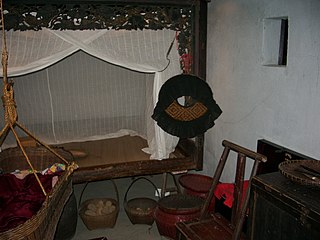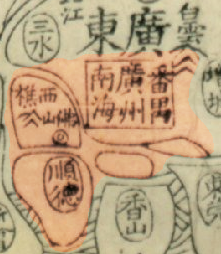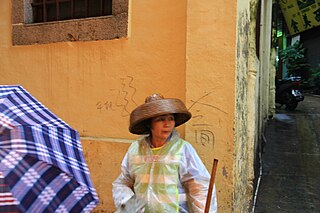This is a list of Cantonese-related topics, which encompasses Guangdong and Guangxi, the Cantonese people, culture and language.

Hong Kong cuisine is mainly influenced by Cantonese cuisine, European cuisines and non-Cantonese Chinese cuisines, as well as Japanese, Korean and Southeast Asian cuisines, due to Hong Kong's past as a British colony and a long history of being an international port of commerce. From the roadside stalls to the most upscale restaurants, Hong Kong provides an unlimited variety of food and dining in every class. Complex combinations and international gourmet expertise have given Hong Kong the reputable labels of "Gourmet Paradise" and "World's Fair of Food".
The sub groups of the Han Chinese people, also known as Sinitic peoples, Chinese dialect groups or just dialect groups, are defined based on linguistic, cultural, genetic, and regional features. The terminology used in Mandarin to describe the groups is: "minxi", used in Mainland China, or "zuqun", used in Taiwan. Other than Hui people, which is a classification for Muslims of all backgrounds, no Han subgroup is recognized as one of People's Republic of China's 55 official minority ethnic groups.

The egg tart is a kind of custard tart found in Macau, Hong Kong, Mainland China, Taiwan, Argentina, Portugal, Brazil, Britain, and various Asian countries. The dish consists of an outer pastry crust and is filled with egg custard and baked.

Punti is a Cantonese endonym referring to the native Cantonese people of Guangdong and Guangxi. "Punti" designates the Cantonese-speaking locals in contrast to the other Yue Chinese people such as the Taishanese; Hoklo people from Fujian who spoke the Hokkien dialects; the Hakka immigrants who arrived in Guangdong and Guangxi during the Qing dynasty; and ethnic minorities such as the Zhuang people of Guangxi, and the boat-dwelling Tanka people who are both descendants of the Baiyue - although the Tanka have largely assimilated into Han Chinese culture.
Wong Shik-Ling (1908–1959) was a prominent scholar in Cantonese research. He is famous for his authoritative book, A Chinese Syllabary Pronounced According to the Dialect of Canton (《粵音韻彙》), which is influential in Cantonese research.

The Cantonese people are subgroup of the Han Chinese people native to and/or originating from the provinces of Guangdong and Guangxi, in southern mainland China. Although more accurately, "Cantonese" refers only to the people from Guangzhou and its satellite cities and towns and/or native speakers of Standard Cantonese, rather than simply and generally referring to the people of the Liangguang region. The Cantonese people share a common native culture, history, ancestry and language. The term "Cantonese people" is often synonymous with the Punti people. They are also referred to as "Hoa" in Vietnam, "Kongfu" in Malaysia and "Konghu" in Indonesia.".
Weitou dialect is a dialect of Yue Chinese. It forms part of the Guan-Bao branch of Yuehai, sometimes called Cantonese. It is spoken by older generations in Luohu and Futian Districts in Shenzhen, and by those in the New Territories, Hong Kong.

Guangdong Television is a television network owned by Guangdong Radio and Television in Guangzhou, Guangdong province in China. Guangdong TV is the oldest television station in Guangdong province, based in Guangzhou, near the Guangzhou TV Station. The station covers Guangdong and Guangxi provinces. At present, Guangdong TV has a staff of around 1,800 people.

The Cantonese Wikipedia is the Cantonese-language edition of Wikipedia, run by the Wikimedia Foundation. It was started on 25 March 2006.

TVS Television, originally known as Southern Television Guangdong is a regional Chinese language sub-network under Guangdong Radio and Television in Southern China. TVS is based in Guangzhou and covers mainly in Guangdong and Hong Kong. Most of the channels programming and broadcast is mainly in Cantonese, with additional Mandarin Chinese broadcasts.

Huadu District is a district of Guangzhou, the capital of Guangdong province, China. It is located in the far northern suburbs of the city.
Guangzhou is a city in China's Guangdong Province.

The Sanyi, Three Counties, or Nanpanshun also known by various Cantonese romanizations such as Sam Yup and Nam Pun Shunrefers to the three former counties of Nanhai, Panyu, and Shunde surrounding Guangzhou and Foshan.
Malaysian Cantonese is a local variety of Cantonese spoken in Malaysia. It is the lingua franca among Chinese throughout much of the central portion of Peninsular Malaysia, being spoken in the capital Kuala Lumpur, southern Perak, Pahang, Selangor and Negeri Sembilan, it is also widely understood to varying degrees by many Chinese throughout the country, regardless of their ancestral dialect.














